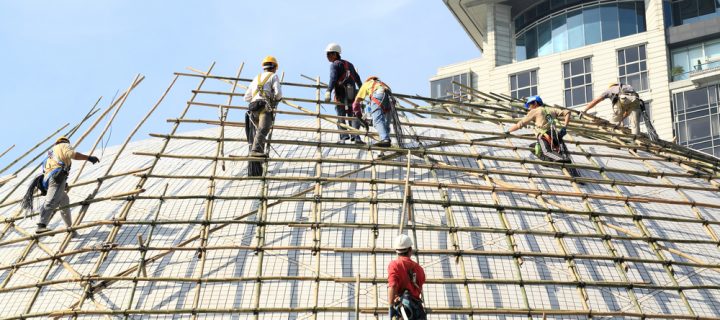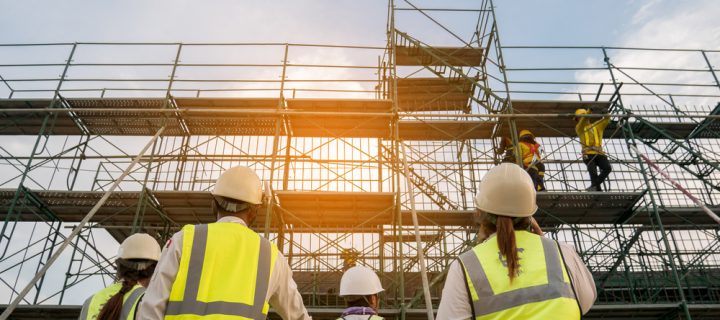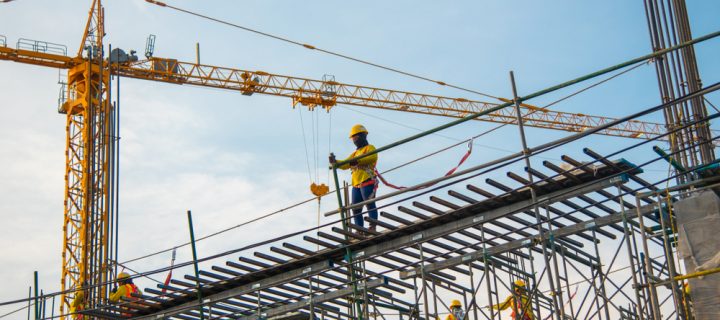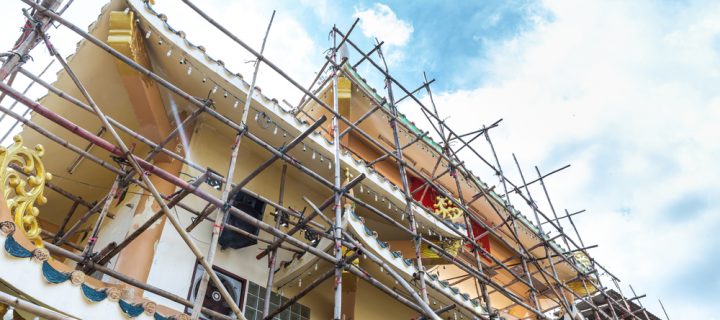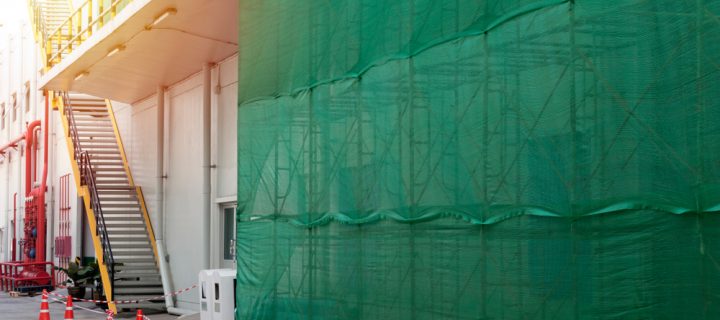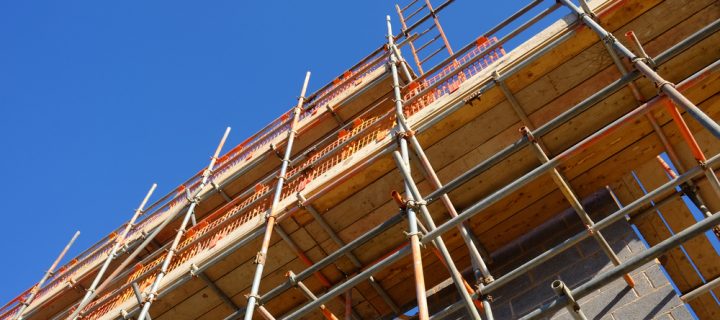In the UK, we are accustomed to seeing steel scaffolding being erected with plastic safety decking littered throughout the construction. However, scaffolding has not always been like this and on top of this, scaffolding is very different in other countries at the moment. Being a premium supplier of scaffolding from Derbyshire, we can not speak to the expertise of other countries and their scaffolding but we can take a look at how their practices differ from ours. Scaffolding has been around for a very long time and since then there have been many variations. Some early records suggest that brass was used for scaffolding instead of steel or aluminium in countries such as Egypt. So let’s take a look at some of the different scaffolding that is used around the world and let’s see how it may vary from our format. Bamboo One of the most notable differences between different scaffolding around the world is the use Bamboo instead of aluminium or steel. Whilst aluminium is significantly more popular in Europe and the western hemisphere, bamboo is the material of choice for scaffolding in a lot of Asian countries such as China, Japan and India. Bamboo scaffolding has some surprising advantages. The material is extremely strong and resilient, making it very effective when it comes to scaffolding. This unique type of scaffolding is quoted as lasting for around 3-5 years. It’s not all so positive when it comes to Bamboo scaffolding however. For safety reasons bamboo can not be used on buildings over 6 stories tall. Additionally, Bamboo shrinks and expands when it gets wet. This can create many problems in more extreme weather conditions. Kwikstage Scaffolding Whilst this type of scaffolding is popular in Scotland, arguably it is most used in Australia. The non-slip platforms and double guard rails significantly improve the safety and reliability of the scaffolding; making it a great an ideal option for countries where the health and safety aspect of the scaffolding is at the forefront. Frame & Brace Scaffolding Frame and brace Scaffolding is particularly popular on residential and commercial projects in North America. This very light scaffolding is extremely popular in North America as it can be easily erected and dismantled. It...
Read Moreabout How is Scaffolding Different Around the World?In the early months of 2022, it seems commonly acknowledged that the job market is booming. Many employers have reported a high demand for employees with there being a particular demand for workers in the manufacturing and construction industry. The Office of National Statistics have predicted they expect there to be another 12 million jobs being created in the next 10 years alone. With so many options available when it comes to employment, you might want to consider, why choose a job in the scaffolding industry? Being a well renowned supplier of scaffolding from Derbyshire, we are proud to highlight the many advantages of working in the scaffolding industry. And perhaps more importantly, we want to help you evaluate if you fit the profile of a future scaffolder. Teamwork As anyone who has ever worked in the manufacturing industry more broadly would tell you, these jobs come with a certain element of teamwork and camaraderie. Many scaffolders cite working in a team being one of the most enjoyable aspects of the job. To work in the scaffolding industry you must ensure excellent channels of communication are upheld at all times for health and safety and efficiency purposes. Accompanying this is fact you have to work closely with your team members. By enacting this technique, tasks are completed to the highest possible standard. Traveling If you are tired of being stuck in one location whilst you work and want a career change; a career in scaffolding might be ideal for you. To erect scaffolding or to implement safety decking, you might have to travel quite a lot. It might go without saying but you may need to travel in this job. Where you will be located will very much depend on where the demand for scaffolding is at its highest. Getting Physically Fit and Being Outdoors If you enjoy fresh air and if you enjoy staying physically fit; working in scaffolding might be right up your street. Many scientists and researchers advise that spending more time outdoors increases your mood. Additionally, staying physically fit has many advantages. As well as having clear visual benefits; it is found that keeping fit also has a positive impact on your mental health. Contact...
Read Moreabout Why Work in the Scaffolding Industry?Nearly a year ago, DerbyshireLive reported of the significant investment which is being made into various projects in aid of boosting the economic growth of the local area as the country emerged from another national lockdown. With so many projects due to begin or revisited this coming year; we thought it might be helpful to take a look at some of the useful information regarding erecting scaffolding in Derbyshire. It was reported a colossal £700 million was invested into around 11 different projects. It was no surprise that PwC Demos Good Growth for Cities estimated the city of Derby; would be one of the fastest to recover from the economic impact of the COVID-19 pandemic. What To Do First? Before even starting to erect your scaffolding, you must ensure you and your colleagues are safe. One of the many ways you can do this is by ensuring the correct training is carried out before hand. Before you start to construct the scaffolding, you will want to thoroughly inspect your working environment. This will help to identify any potential hazard and problems that could arise later in the project. The Winter Months Like many UK destinations north of London, weather conditions can get quite treacherous and unpredictable in the winter months. This can create quite the conundrum when it comes to how best to erect your scaffolding. Some of the extra advice we have during the winter is: Ensure good communication is available between your employees– When putting up your scaffolding it is of paramount importance to ensure employees working on site have easily accessible lines of communication to each other incase of any potential accidents or incidents. Make sure employees wrap up warm– This one might seem like a no-brainer, even if you employee does not like wearing warmer clothing, ensure they are wearing appropriate clothing. During the colder months, it can get very cold in Derby. This rings especially if you are working at higher altitude. Ensure non-slip footwear is worn– Following on from our recent comment, wearing non-slip footwear should be mandatory especially during colder months where the weather is not as glorious. Winter months can be extremely wet and slippery, therefor, appropriate footcare is required. Employees...
Read Moreabout Winter Tips for Erecting Scaffolding in DerbyshireNetwork Scaffolding have been providing high quality scaffolding in Derby and across the neighbouring counties for many years now. And 2022 promises to be a fantastic year for all involved in the scaffolding industry. Back in March 2021, CITB (the Construction Industry Training Board for the UK) projected that by 2028 there will be over 350,000 jobs in the construction industry, further highlighting the ever increasing need for top quality scaffolding. Furthermore, IBIS World cited back in 2020 that there are already over 36,000 employees in the scaffolding industry. As the statistics clearly indicate, 2022 promises to be a very important year for the scaffolding industry. We would like to take this opportunity to highlight some of the most important features we will be focusing on for this coming year and going forward. Health & Safety Most scaffolding providers will always highlight health and safety procedures as a prominent and important feature of the industry. We have frequently referred to the fact that we take health and safety very seriously. This is reinforced by the fact we are proud participants of the BS OHAS 18001:2007 certification scheme. Access Scaffolding Erecting Whilst we offer a vast array of scaffolding services, we would like to highlight access scaffold erecting. We are proud to announce that we will be providing top quality access scaffolding to individual and commercial customers throughout the coming year. If you would like a quick reminder of some of the many benefits of this particular type of scaffolding, allow us to elaborate: Versatility and Adaptability to Suit Required Site Easy to Erect and Dismantle More than Adequate Workspace Safety Contact Us Did you know that we even offer access scaffolding in Nottingham, Loughborough, Derbyshire and throughout Staffordshire? If you are in the surrounding areas of Derbyshire and you have a query regarding Scaffolding, do not hesitate to contact us. In Addition, be sure to keep up-to-date with our website throughout...
Read Moreabout Providing High Quality Scaffolding in 2022Scaffolding netting is one of a number of tools used in the construction industry when working with scaffold structures. Its main objective is to better protect the workers and the people working around scaffold such as dust, heat, rain and any other hazard. For this blog, Network Scaffold will talk you through all the advantages of using netting on your next project. How Does Scaffolding Netting Protect? Scaffold netting protects both employees working on the construction project and the general public who are in close proximity to the project. An Extra Layer of Fall Protection For workers on construction projects, they will gain an extra layer of fall protection with netting. When regular scaffold is set up, there are guardrails and toe rails that act as barriers to prevent workers from falling. Netting ensures full coverage instead of just protection where the rails are located. Provide Shade The netting also provides shade for employees. The amount will depend on the density of the netting and the sun direction. Scaffolding netting a surprisingly effective way to protect workers in hot and/or sunny conditions. From the Elements Similar to the shade rate, netting protects workers from the elements, especially the wind. Shielding from the wind significantly helps works outside during the winter plus it will make performing their tasks easier. Netting also provides protection against any debris that could accidentally fall, including tools or building materials. Passersby Dust-intensive work such as sandblasting creates plenty of dust, but using netting will retain the sand and save polluting the surrounding area. What to Look For in Scaffold Netting When deciding on scaffold netting, there are a number of factors to consider. Here are some things to think about – Fire Retardant – While most products sold today are fire retardant, it is always a good point to check before purchasing. You will want to ensure that in the case of a fire, the netting doesn’t act as extra kindle and become ablaze quickly. UV Resistant – The amount of UV resistance ultimately depends on the length of time the netting will be in place, but you will want to ensure some resistance so it can stay outside and resist the elements. Reinforcement –...
Read Moreabout What is scaffolding netting?Scaffolding from Network Scaffold Services is a complex and specially designed construction of metal pipes and tubes, which is primarily used to support structures. While our structures are commonly used for domestic property projects such as loft conversions or extensions. But they are also used on commercial sites for a number of reasons. For our latest post, we will tell you all the commercial uses for our scaffold structures. Using Scaffolding for Construction and repairs Despite the amount of equipment and tools available, including cranes and extendable ladders, scaffolding is the most cost-effective way of constructing a building. According to industry statistics, around 2.3 million or 65% of construction workers use scaffolds in their work. Shopping centres, banks, cafes, small retail shops and other commercial properties can all benefit from using scaffold structures with no limit on size. Whether areas are being expanded or built from scratch, scaffold helps workers reach heights safely. It is also used for repairs and renovations, so buildings, landmarks and tourist attractions are kept in great condition. Using bespoke scaffold structures makes it easier to access, which can be designed by Network Scaffold Services. Advertising Large scale posters and other forms of advertising offer excellent visibility for brands and companies. Catching the eye of passersby and commuters by using scaffolds to advertise products, events or services is a great idea. Some billboards also use scaffolds to hold them up plus make it easier to replace a poster with another. Entertainment Concerts, gigs and other forms of entertainment all incorporate scaffolds to erect different parts of the stage and set up. For bigger arena’s; a lot of work goes into the show’s production with a professional team working long hours to give ticket holders the best experience. Because scaffolding is very flexible; it can be built around different structures as and when needed, which is useful for installing lighting, seating, special effects or sound systems. Contact to Find Out More Here at Network Scaffold Services, we can design and inspect scaffold structures to make sure you have the best setup for your project. If you have any questions, please do not hesitate to get in touch...
Read Moreabout How is scaffolding used on commercial buildings?
